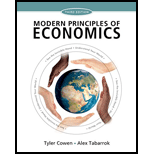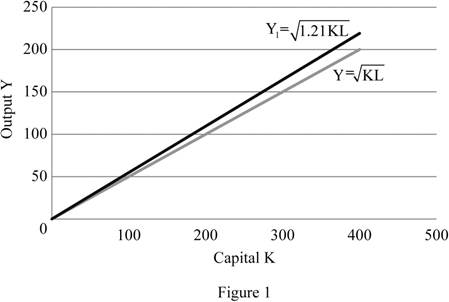
Sub part (a):
Steady state level of output.
Sub part (a):
Explanation of Solution
The steady state level of output is calculated as follows:
The steady state level of output is 200 units.
Concept introduction:
Sub part (b):
Solow diagram to show short run impact.
Sub part (b):
Explanation of Solution
Figure 1 depicts Solow diagram which shows the short run impact of a 21% increase in the amount of labor available.

In figure 1, the horizontal axis represents the capital (K) and the vertical axis represents the output (Y). The initial production function
Concept introduction:
Economic growth: The economic growth is the increase in the overall goods and services produced per head in the economy over a specific period of time.
Solow growth rate The Solow growth rate is the rate of economic growth with given flexible price, and the existing real factors of capita, labor and knowledge. The Solow growth rate is an economy’s potential growth rate.
Sub part (c):
Steady state level of output.
Sub part (c):
Explanation of Solution
The new steady state level of output is calculated as follows:
The new steady state level of output is 220 units.
Concept introduction:
Economic growth: The economic growth is the increase in the overall goods and services produced per head in the economy over a specific period of time.
Sub part (d):
The new steady state level of output in the diagram.
Sub part (d):
Explanation of Solution
The new steady state level of output is 220 units which is depicted in the figure 1.
Sub part (e):
Action to gain long lasting benefits from the increase in capital stock.
Sub part (e):
Explanation of Solution
The initial production function is algebraically represented as follows:
Squaring both sides,
And solving for K, we get
Substitute K into the steady-state condition
And solve for Y by multiplying L and dividing by
Similarly, the new production function can be algebraically represented as follows:
Substitute K into the steady-state condition
And solve for Y by multiplying L and dividing by
Equating (1) in (2) we get
Substituting the values in equation (3) we get
Further, the percentage change in the output is depicted as follows:
This implies the steady-state level of output will grow by 21% per cent in the long run.
Concept introduction:
Production function: It is the relationship between the inputs employed by a firm and the maximum output the firm can produce with those inputs.
Sub part (f):
Output per worker.
Sub part (f):
Explanation of Solution
The output per worker in the initial steady state is calculated as follows:
The output per worker in the initial steady state is 2 units per labor.
The output per worker in the short run is calculated as follows:
The output per worker in short run is 1.82 units per labor.
The output per worker in the initial steady state is calculated as follows:
The output per worker in the long run is 2 units per labor.
Sub part (g):
New immigration policy and its effect.
Sub part (g):
Explanation of Solution
The citizens of the country are neither made worse off nor better off in the long run by a new immigration policy. This is because the new long-run level of output per worker compare with the initial level of output per worker remains unchanged which is 2 units per labor. This is unlike the short run effect which has lower output per worker. In the long run, the steady output level is determined largely by the
Concept introduction:
Depreciation: Depreciation is the process of decreasing the value of an asset over time especially due to wear and tear.
Investment: The investment is the money invests in terms of assets and building by the individual for the future consumption and profit making.
Sub part (h):
New steady state level of capital.
Sub part (h):
Explanation of Solution
The new steady state level of capital is calculated as follows
We know
Also
Equating all these we get,
Substituting the values we get
Thus the new steady state level of capital is 484, so that
Want to see more full solutions like this?
Chapter 28 Solutions
EBK MODERN PRINCIPLES OF ECONOMICS
- G Interpret the following estimated regression equations: wagehr = 0.5+ 2.5exper, where wagehr is the wage, measured in £/hour and exper is years of experience, colGPA = 1.39.412 hsGPA where colGPA is grade point average for a college student, and hsGPA is the grade point average they achieved in high school, cons 124.84 +0.853 inc where cons and inc are annual household consumption and income, both measured in dollars What is (i) the predicted hourly wage for someone with five years of experience? (ii) the predicted grade point average in college for a student whose grade point average in high school was 4.0, (iii) the predicted consumption when household income is $30000? =arrow_forward1. Solving the system of inequalities: I≥3 x+y1 2. Graph y=-2(x+2)(x-3) 3. Please graph the following quadratic inequalities Solve y≤ -1²+2+3arrow_forwardNot use ai pleasearrow_forward
- not use ai pleasearrow_forwardWhat are the key factors that influence the decline of traditional retail businesses in the digital economy? 2. How does consumer behavior impact the success or failure of legacy retail brands? 3. What role does technological innovation play in sustaining long-term competitiveness for retailers? 4. How can traditional retailers effectively adapt their business models to meet evolving market demands?arrow_forwardProblem 1.1 Cyber security is a very costly dimension of doing business for many retailers and their customers who use credit and debit cards. A recent data breach of U.S.-based Home Depot involved some 56 million cardholders. Just to investigate and cover the immediate direct costs of this identity theft amounted to an estimated $62,000,000, of which $27,000,000 was recovered by insurance company payments. This does not include indirect costs, such as, lost future business, costs to banks, and cost to replace cards. If a cyber security vendor had proposed 8 years before the breach that a $10,000,000 investment in a malware detection system could guard the company's computer and payment systems from such a breach, would it have kept up with the rate of inflation estimated at 4% per year?arrow_forward
- Not use ai pleasearrow_forwardAnalyze financial banking products from the Asset-Based Financial Products side (like credit cards, loans, mortgages, etc.). Examine aspects such as liquidity, risk, and profitability from a company and an individual point of view. Ensure that the interventions demonstrate analytical skills and clearly express the points of view regarding the topic.arrow_forwardprovide source where information was retrieved NAME OF SCHOOL: Florida Polytechnical college ADDRESS: PRIVATE OR PUBLIC: ENTRY REQUIREMENTS - GPA, SAT/ ACT SCORES: IN STATE TUITION COST: DORMITORY COST: OFF CAMPUS HOUSING OPTIONS: AVERAGE MONTHLY RENT FOR A ROOM in the area: MEAL PLAN: Do they have them? Are they mandatory for freshmen? How much $: CAMPUS SIZE: (don't put acres - is it a small, medium, or large campus?) TEACHER STUDENT RATIO/CLASS SIZE: NUMBER OF UNDERGRADUATE (freshmen, soph, junior, seniors) STUDENTS ON CAMPUS: FINANCIAL AID/SCHOLARSHIPS OPPORTUNITIES: ACCEPTANCE RATE: GRADUATION RATE: ONLINE OPTION? BUSINESS DEGREES: (list them) ACADEMIC SUPPORT - TUTORING: JOB PLACEMENT/CAREER SERVICES: what % of students get lined up with jobs right out of college with the school's help? INTERNSHIP OPPORTUNITIES: Paid? Unpaid? STUDY ABROAD PROGRAMS: Do they exist? How much $? SPORTS: Competitive - D1, D2, D3, etc? Intramural? (non-competitive sports opportunities) CLUBS: How many?…arrow_forward
- Explain the following: How is 4 to 5 a 22% increase? How is 100 to 80 a 22% decrease? Not pictured: How is 100 to 90 a 11% decrease? How is 100 to 50 a 67% decrease?arrow_forwardWithout Trade Production Consumption With Trade Production Everglades Denali Shorts (Millions of Almonds Shorts Almonds pairs) (Millions of pounds) (Millions of pairs) (Millions of pounds) 12 16 5 30 12 16 5 30 64 0 0 20 Trade action Imports 13 ▼ Exports 39▾ Imports 13 ▼ Exports 39 Consumption Gains from Trade Increase in Consumptionarrow_forwardPractice: Their labor forces are each capable of supplying four million hours per week that can be used to produce shorts, almonds, or some combination of the two. Country Shorts Almonds (Pairs per hour of labor) (Pounds per hour of labor) Everglades 4 16 Denali 5 10 Suppose that initially Denali uses 1 million hours of labor per week to produce shorts and 3 million hours per week to produce almonds, while Everglades uses 3 million hours of labor per week to produce shorts and 1 million hours per week to produce almonds. As a result, Everglades produces 12 million pairs of shorts and 16 million pounds of almonds, and Denali produces 5 million pairs of shorts and 30 million pounds of almonds. Assume there are no other countries willing to engage in trade, so, in the absence of trade between these two countries, each country consumes the amount of shorts and almonds it produces. Everglades's opportunity cost of producing 1 pair of shorts is4 pounds of…arrow_forward

 Principles of Economics (12th Edition)EconomicsISBN:9780134078779Author:Karl E. Case, Ray C. Fair, Sharon E. OsterPublisher:PEARSON
Principles of Economics (12th Edition)EconomicsISBN:9780134078779Author:Karl E. Case, Ray C. Fair, Sharon E. OsterPublisher:PEARSON Engineering Economy (17th Edition)EconomicsISBN:9780134870069Author:William G. Sullivan, Elin M. Wicks, C. Patrick KoellingPublisher:PEARSON
Engineering Economy (17th Edition)EconomicsISBN:9780134870069Author:William G. Sullivan, Elin M. Wicks, C. Patrick KoellingPublisher:PEARSON Principles of Economics (MindTap Course List)EconomicsISBN:9781305585126Author:N. Gregory MankiwPublisher:Cengage Learning
Principles of Economics (MindTap Course List)EconomicsISBN:9781305585126Author:N. Gregory MankiwPublisher:Cengage Learning Managerial Economics: A Problem Solving ApproachEconomicsISBN:9781337106665Author:Luke M. Froeb, Brian T. McCann, Michael R. Ward, Mike ShorPublisher:Cengage Learning
Managerial Economics: A Problem Solving ApproachEconomicsISBN:9781337106665Author:Luke M. Froeb, Brian T. McCann, Michael R. Ward, Mike ShorPublisher:Cengage Learning Managerial Economics & Business Strategy (Mcgraw-...EconomicsISBN:9781259290619Author:Michael Baye, Jeff PrincePublisher:McGraw-Hill Education
Managerial Economics & Business Strategy (Mcgraw-...EconomicsISBN:9781259290619Author:Michael Baye, Jeff PrincePublisher:McGraw-Hill Education





